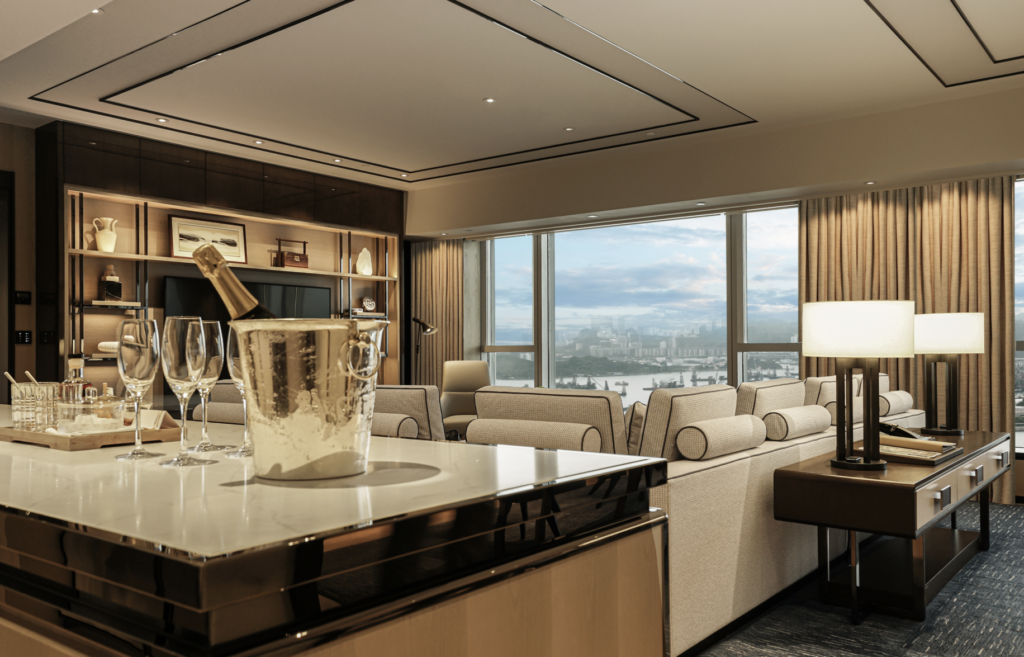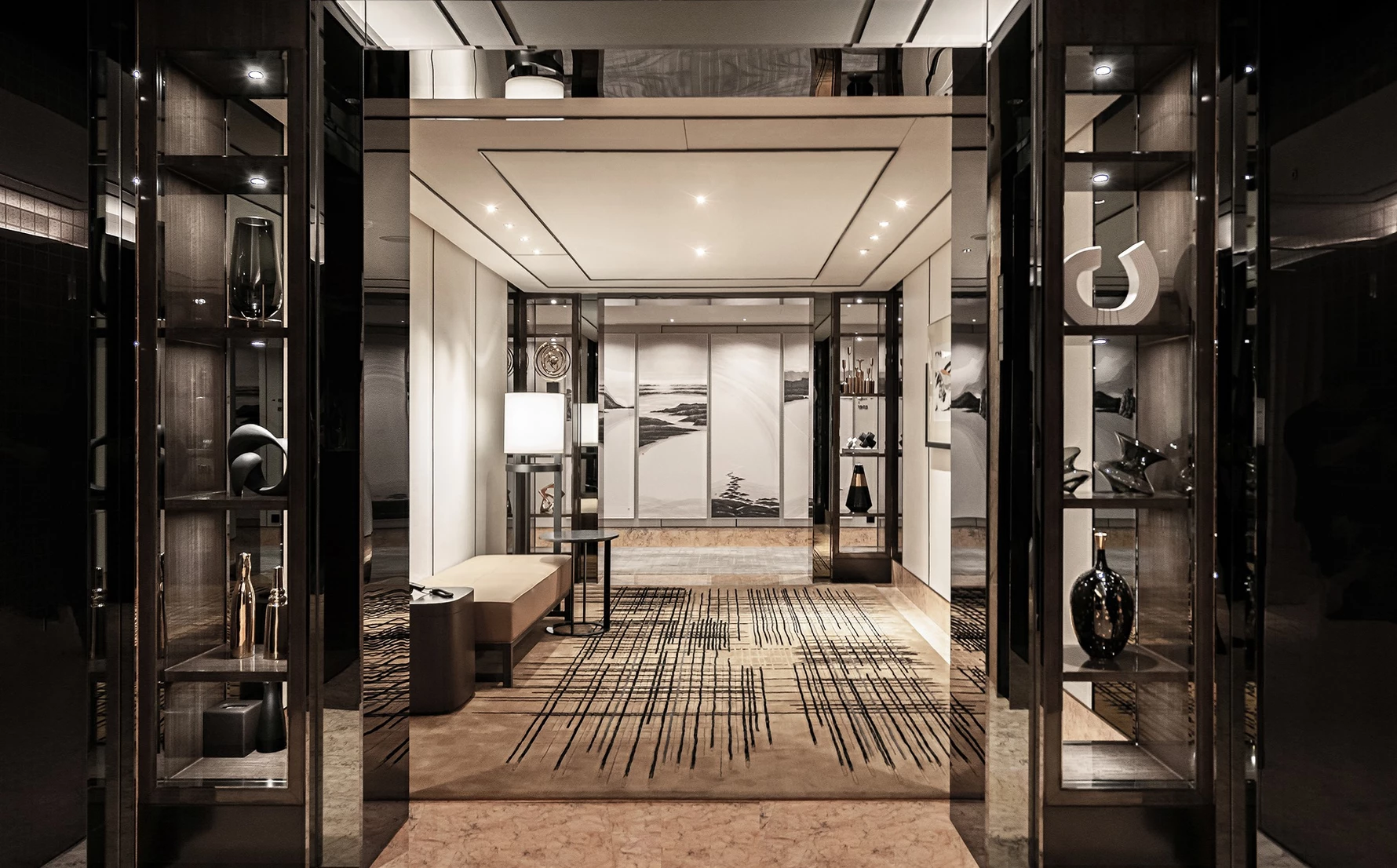For a Western interior designer based in LA, how Peter Remedios became the definitive go-to guy for the most important hotels and properties in the region is a story worth investigating. So we did. As luck would have it, the man himself was in town to unveil the latest suites at the Four Seasons Hong Kong.
Remedios’ stellar reputation lands long before he does; over 30 years of expertise in the field of high-end hotel and resort design as Principal Designer and Managing Director of Remedios Studio. Founded in California (in 2007), the Hong Kong branch was subsequently set up in 2010.
Studded around the region here in Asia, you can find the constructed portfolio of Remedios Studio, standing tall and wide. Be it the understated elegance of The Ritz Carlton Kyoto, the extreme glamour of Morpheus Hotel in Macau, the subtle sophistication of Qujian Rose Garden (luxury property) in Xi’an, you’ll find his signature in places the average Westerner couldn’t find on a map; Tasuro in Xi’an, Niccolo in Chengdu or The Puxuan Hotel & Spa in Beijing.

Creating contemporary design with a distinctive local flavour and touch, his work honours and expresses the timeless beauty of the indigenous culture and heritage of wherever he’s building. If he’s designing something in Tokyo, there are distinct Japanese brushes, in Hong Kong, he’s mixed the modern and the ancient–a reflection of the city itself. A custodian of both tradition and innovation, he has created inspiring destinations with a unique sense of place. It’s no wonder his passport is full of stamps from places familiar to us, but not the average Westerner. That begs the chicken-and-egg question, did clients find him or did he find them?
How did he become the go-to interior designer for innumerable Asian projects (his website features his comprehensive portfolio) in the region? This and several dozen questions linger as we are escorted to the upper echelons of Four Seasons Hotel Hong Kong

As we enter the newly appointed suites, Remedios’ voice superscripts the air as he points out the design details. “As you come through the entrance, from the second the lift doors open, I want this to feel like you’re entering into the foyer of a glamorous friend’s mansion or penthouse. The sense of just walking through from lobby to room should be seamless.”
“It feels more hushed. It feels more intimate. It feels like you’re home, not a cold, stoic hotel. Walking down to your room, it should feel like a private apartment the moment you enter. It feels very comforting, it feels like there’s almost a familiarity to it even though you’ve never been here before right?”
Right. Familiarity is what one feels when meeting the amiable Remedios, like an old friend welcoming you home after a long journey. “The space-it doesn’t and shouldn’t feel commercial. That was very important to me.”
Indeed the latest suites at the Four Seasons are stunning, with views of Hong Kong reserved mostly for postcards. With the cascade of Chinese scrolls and paintings in well appointed rooms, a TV cabinet filled with artful knick-knacks, tokens you’d find from the well-travelled, miniature sculptures, art, framed photographs… you’ve snuck into someone’s living room, not a hotel suite to be peopled by strangers.
“It’s about a concept that I call the luxury of choice and the luxury of time. This is what you’d have at home, right? You’d have family, you’d have friends over so you need this space to feel good, warm, elegant but accessible.”
As we sit down for a tête-à-tête with the verbose and articulate Remedios, we scrap the Q&A plans and just go with the flow of conversation. Before we sit, he reveals discreet drawers and lighting on the island by the far end of the living space. Cabinets filled with wine glasses, snacks, tools to open bottles all neatly tucked into every nook and niche. For anyone finicky about design, its polished perfection. “Everything falls into a place – and that to me, is luxury. That to me is knowing that somebody thought about me, that the designer cared. Somebody thought about the end customer, thought about how to make them happy and how to make one feel pampered. And that’s how you pamper through design; ease and forethought.”
Cabinets light up when you open them, there’s soft music perforating the air when you enter the wash, there are no wires, visible cables, where are the speakers?
“I wanted the room’s look to be modern. I want it to be technologically advanced. And in Hong Kong, we have all the latest technology here. I want it to be sophisticated, stylish, worldly, savvy. Is there anything uglier than wire cables?”

No, especially in photos.
“I wanted the heart and soul to feel Chinese. So each suite has a signature piece that no other room does. I didn’t want the closet doors to be so obvious, so we bring in this Song Dynasty inspired patterning, we brought in paintings of mountains and mist and framed the room-push into the painting, its in fact a closet door. I disguised the closet! I imagined, if I’m lying on the bed, do I want to see handles and drawers or do I want to see a beautiful piece of art?”
“The hardware of sliding doors was tricky so we had it specially built, to make it function so that the art looks like it’s just kind of floating in space, unsupported – but it just slides open.”
How do you see design?
I see design really as a composition. It’s a composition of proportions. When you study the silhouette of Chinese architecture, it’s tall and slender. Slender columns, symmetry. Look at imperial doors in Chinese palaces, they come in identical pairs, in harmony, look for the perfect symmetry. When I stand back and look at the rooms, I must see symmetry and long clean lines. This room is actually inspired by Ming Dynasty furniture, dark wood but with a polished lacquered finish. Because of modern technology, we would blast it with with lacquer to give you a shiny finish, but still the beauty of the wood pattern remains. We custom designed even the furniture to fit into this space.
The central topic in design this year seems to be sustainability. How have you incorporated that?
I have been talking about sustainability for years – this is not a new concept for our studio. Let me give you an example from this hotel here itself. We looked at the prospect and we didn’t see the need to demolish the room and start from scratch. First of all, to extract rock from quarry, the cost of it-and I don’t mean monetary cost, but the price of leaving scars on landscape. These quarries, when they cease to operate and people don’t know what to do with them, its a completely scarred landscape. Nothing will ever grow there again. So why do we throw away something we don’t have to? Plus all that waste ends up in a landfill somewhere. When you come inside this room, this feels and looks brand new, but we didn’t desecrate and demolish to build on top of it. So when you talk about sustainability, I didn’t destroy all the stone and all the marble and all that raw material. The room is largely, I would say 90%, what it was, when it was originally built and yet look at the before and after-its nothing like what it was.
You’ve said in past interviews, you can find inspiration anywhere.
See the lining and border in every feature in the bathroom? I was inspired by a Chanel jacket! A particular collection where I noticed, every piece had a thick black border. It makes things stand out. This is a sort of a study in black in kids geometry. Apart from the aesthetic, it serves a purpose. I wash my hands and I spilled water on the counter – ruining the things placed on it. With the black border, I’ve indented it so the water never spills out. This philosophy of caring design, why we did this colour scheme, there’s so much thought that goes into every little detail.
One of the main questions we had in the office at Robb Report Hong Kong…
Yes, I respect your magazine so much.
…I’m so glad you do – the thing that we noticed was you’ve had a such a storied career around Asia and you’ve worked with competing brands. Hotel properties that are across the road from each other. How do you balance it?
When I start on any project, I think of what is the story behind it first – and how do I further extend that story. No two tales are the same. What I would think for something like The Mandarin Oriental will not be the same for The Landmark. Their narratives are different. You cannot have a cookie-cutter approach to design.

What stands out in your own portfolio?
One of the first projects I ever did, Four Seasons Hotel New York, with the famed architect, I.M. Pei. A spectacular project, working with a legend like Pei, if ever there’s someone iconic in the industry. It was a privilege to work on a project like that. It’s still one of the benchmarks of New York.
How big is your research department?
A lot of us in the company are well traveled in my team. This is one of the things I say quite a lot in interviews. As a kid in school, I used to hate history-the most boring subject because you’ve got to memorise all these dates, events, and places that don’t mean anything to you at all. And then when you get into architecture and design, it’s all you do; research and development! But now, its so fascinating. The Ottoman Empire, or that’s Moorish architecture, why Spanish architecture has Arabic influence-do your history homework and you’ll know why. In design, I found history suddenly interesting. Culture influences architecture, it influences people and it influences the narrative. It allows you to create stories through buildings. You know what is boring? A design with no story.
You’ve worked on so many resorts and holiday properties – when you have time off yourself, can you relax or are you looking at design elements? Have you had a vacation at a place you designed?
No. I stay at other people’s property – and I’ve learned to switch on and off from work. I believe to be good at what you do however, in architecture and design, you have to eat, sleep, dream design, right? You know the expression, if you have found your passion you never work another day in your life? So I don’t think of what I do as work. I actually enjoy it. I love it.

When I go on vacation, I say I’m benchmarking. It inspires me to see the world. I remember I had gone to a property in Bali, for instance. I was with my girlfriend at the time and had not completely switched off from work. There were some important deadlines and decisions and in my suite there was a mini office. I kept thinking – that was so thoughtful they had another little room, like a study in the villa, off the master bedroom where I could make or take a call and not wake her up. You don’t want an office on holiday, but when you’re in charge of companies, work overflows into vacation time – it is not ideal but it happens to everyone. That little office was such a great idea, I said why don’t we do this more? I mean, these are sort of things we talked about, caring design, right? Somebody thought about how heads of industry, the stock market, bankers, lawyers will need to work and not disturb their family. Some kind of decision maker will need to get that urgent call and need to be connected, maybe not at all times, but there will be some weird time. Someone foresaw this in holiday properties in Asia – and its not that common in the West.
Have you noticed a particular difference between the aesthetic in Asia versus the West?
In my experience, it has been different. I’ve spent the better part of my life and career working out of California. Even though I was based in California, most of my projects have been international ones. California is a nice place to live, but work took me around the globe. In my experience, Asia is very forward thinking in terms of design. They are more receptive to new things, bold new ideas. Even in a place like Hong Kong.
Hong Kong is very expensive place to build. The construction costs are very, very high. It’s astronomical, in fact. But when I think back on the early days of working here, you could build for a lot less in Asia than you could in the US. That’s the reason why long-standing Asian hotels are so much more luxurious than their American counterparts. I don’t want to name any brands, but you talk about certain luxury hotels in the US and then you look at their Asian counterpart – its at least one notch above it not two.
How has trend changed?
There was a time I think that when America was America, very forward thinking, the driver of popular culture. The drivers have changed; there was Japan, now there’s Korea and here’s Hong Kong. Look around Hong Kong, some of the most incredible properties are right here. Do you know how good you have it here?
All images courtesy of Petrie PR.









